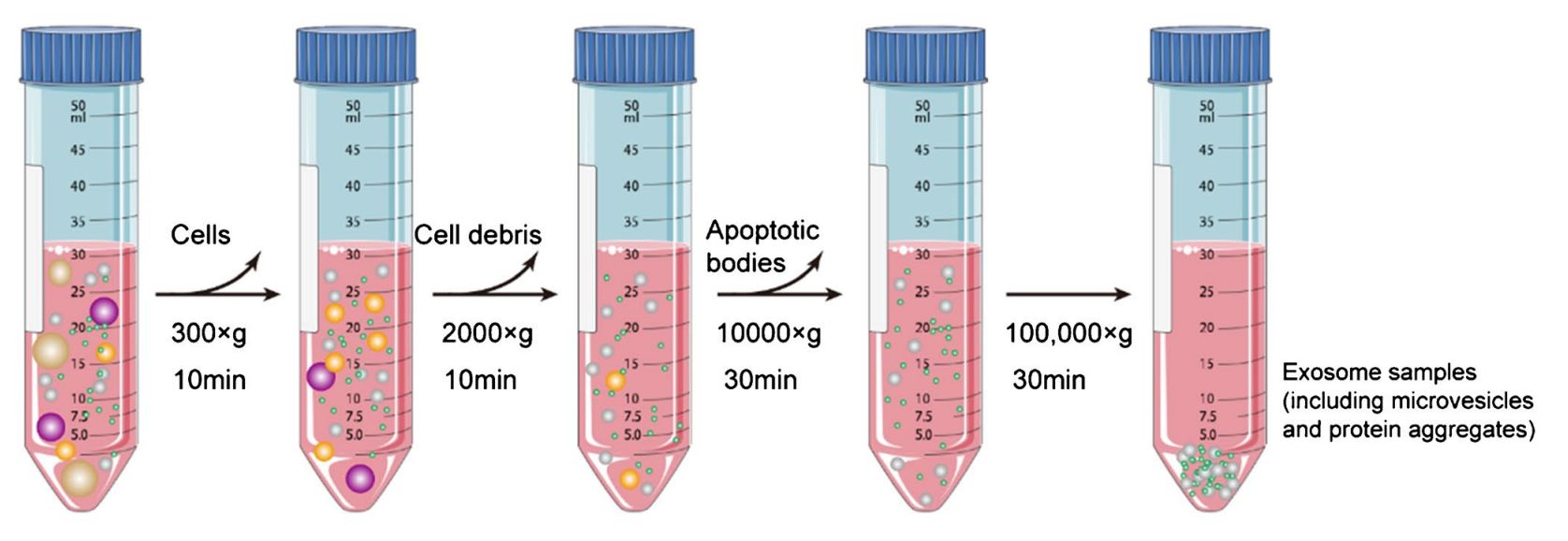Exosome Isolation by Differential Ultracentrifugation (dUC)
Centrifugation is often used to isolate and purify particulate materials as well as polymeric. Depending on the applied centrifugal force, the particles in a non-homogeneous mixture (suspension) can be separated sequentially according to size, density, and shape. With the optimization of centrifugation technologies, differential ultracentrifugation (dUC) is created, which generates extremely high centrifugal forces and plays an essential role in exosome separation. Exosome isolation based on dUC is considered the gold standard and is one of the most commonly used and reported technologies for exosome preparation.
Creative Biostructure has extensive experience in dUC-based exosome isolation. We can provide efficient exosome isolation services to produce pure exosomes for further characterization and function analysis.
dUC Technology Principle and Process
Isolation of exosomes by dUC typically consists of a series of centrifugation cycles of varying centrifugal forces and durations, based on the difference in density and size compared to other components of the sample. Specific steps include:
1. Cleaning of the sample before isolation to remove large biological particles and addition of protease inhibitors to prevent degradation of exosome proteins.
2. Centrifugation at low speeds to remove cellular and apoptotic debris and at high speeds to eliminate larger vesicles and precipitate exosomes.
3. Finally, the exosome isolation is resuspended again and stored at -80°C until further analysis.
 Figure 1. Schematic of differential ultracentrifugation–based exosome isolation. (Liu WZ, et al., 2022)
Figure 1. Schematic of differential ultracentrifugation–based exosome isolation. (Liu WZ, et al., 2022)
Why Can Exosomes be Isolated by dUC?
- Exosomes have a characteristic size range of approximately 30-150nm, which distinguishes them from other extracellular vesicles and cellular debris. This size range allows them to be separated from larger particles by a differential centrifugation process.
- Exosomes have a unique buoyant density due to lipid bilayer membrane composition. By utilizing density gradient centrifugation in combination with differential centrifugation, exosomes can be further purified based on their density.
Which Samples Can dUC Be Used for Exosome Isolation?
The dUC technology is typically used for tissue exosome isolation and is suitable for analyzing large sample volumes. Some of the common samples in which exosomes can be isolated using dUC include:
- Cell culture supernatant
- Cerebrospinal fluid
- Amniotic fluid
- Serum
- Ascites
- Saliva
- Plasma
- Amniotic fluid
- Urine
Notably, the composition and complexity of different sample types may vary, which may affect the efficacy and optimization of the dUC technology for exosome isolation. Depending on the specific sample type and downstream application, the protocol may need to be modified or additional purification steps incorporated.
Additionally, if you are looking for exosomes isolated from body fluids, take a look at the high-quality exosome products offered by Creative Biostructure.
| Cat No. | Product Name | Source |
| Exo-EV-A-001 | HQExo™ Exosome-Bovine Plasma exosome | Exosome derived from Bovine Plasma |
| Exo-EV-A-002 | HQExo™ Exosome-Canine Beagle Plasma exosome | Exosome derived from Canine Beagle Plasma |
| Exo-BF01 | HQExo™ Exosome-CSF | Exosome derived from human pooled CSF (healthy donors) |
| Exo-BF12 | HQExo™ Exosome-Human biofluids ascites fluid | Exosome derived from Human Ascites Fluid (healthy donors) |
| Exo-BF11 | HQExo™ Exosome-Human breast milk | Exosome derived from Human Breast Milk (healthy donors) |
| Exo-BF06 | HQExo™ Exosome-saliva | Exosome derived from human saliva (healthy donors) |
| Explore All Exosomes Isolated from Body Fluids | ||
Why Choose dUC to Isolate Exosomes?
- It is a widely accepted method for exosome isolation and has been validated and optimized in numerous researches.
- It typically yields relatively large quantities of exosomes compared to some other isolation methods.
- It can be applied to a wide range of sample types.
- Exosomes isolated using the dUC technology are compatible with downstream analyses and can be further characterized and analyzed.
By harnessing the power of dUC, Creative Biostructure ensures that high-quality exosomes are isolated, providing valuable insights and helping clients drive groundbreaking discoveries in the fields of regenerative medicine, diagnostics, and drug development.
In addition, we offer high-quality exosome kits for simple and rapid isolating exosomes. If you are interested in our services and products, please feel free to contact us. We look forward to working with you.
References
- Liu WZ, et al. Current status and outlook of advances in exosome isolation. Anal Bioanal Chem. 2022. 414(24): 7123-7141.
- Sidhom K, et al. A Review of Exosomal Isolation Methods: Is Size Exclusion Chromatography the Best Option?. Int J Mol Sci. 2020. 21(18): 6466.
- Li P, et al. Progress in Exosome Isolation Techniques. Theranostics. 2017. 7(3): 789-804.
